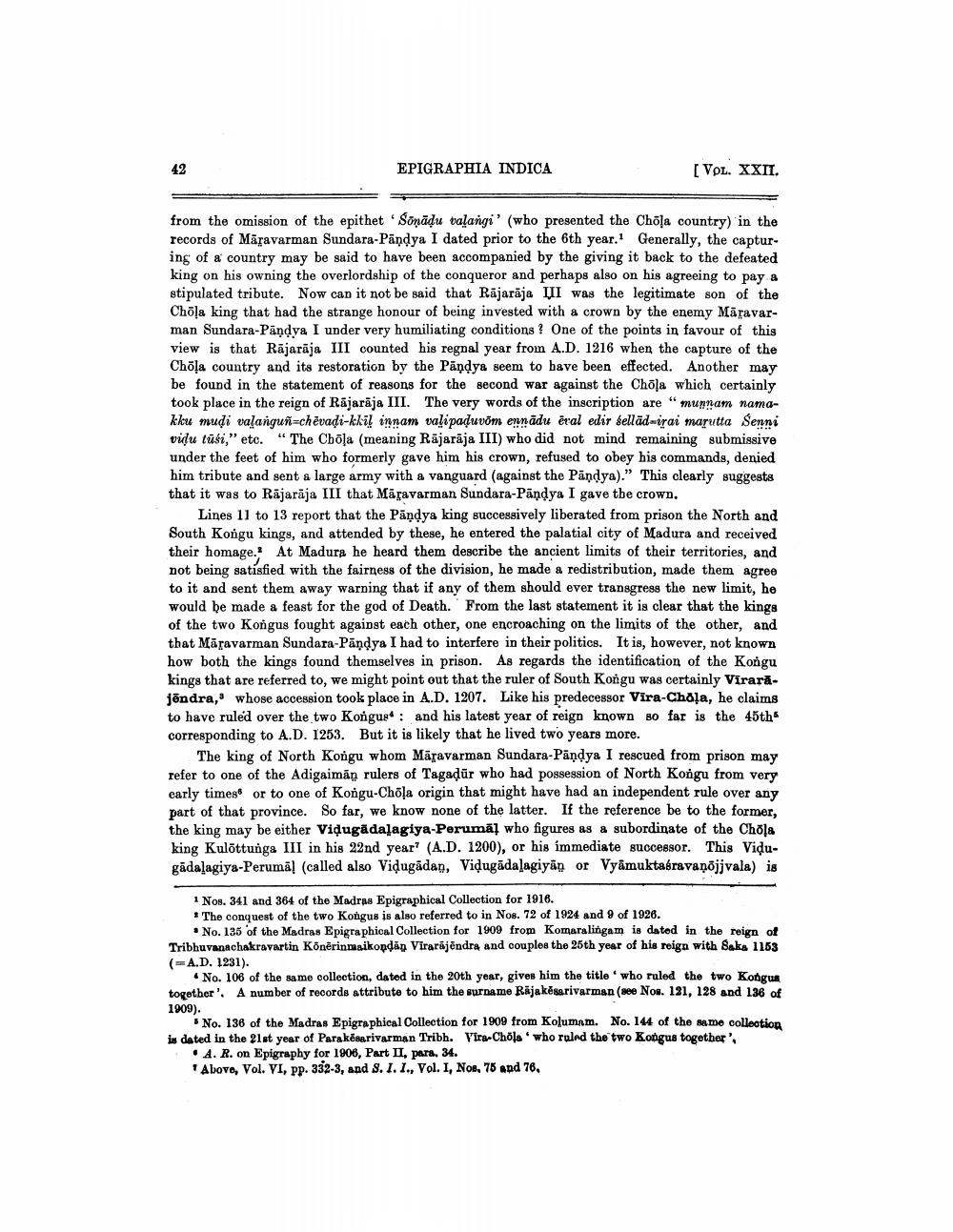________________
EPIGRAPHIA INDICA
[VOL. XXII.
from the omission of the epithet 'Somādu valangi' (who presented the Chõļa country) in the records of Māravarman Sundara-Pāndya I dated prior to the 6th year.1 Generally, the capturing of a country may be said to have been accompanied by the giving it back to the defeated king on his owning the overlordship of the conqueror and perhaps also on his agreeing to pay a stipulated tribute. Now can it not be said that Rājarāja III was the legitimate son of the Chēļa king that had the strange honour of being invested with a crown by the enemy Māravarman Sundara-Pandya I under very humiliating conditions ? One of the points in favour of this view is that Rājarāja III counted his regnal year from A.D. 1216 when the capture of the Choļa country and its restoration by the Pāņdya seem to bave been effected. Another may be found in the statement of reasons for the second war against the Chola which certainly took place in the reign of Rajarāja III. The very words of the inscription are "munnam namakku mudi valangun-chevadi-kki innam valipaduvom ennādu ēral edir sellād-irai marutta Senni vidu tūsi," etc. "The Cbēļa (meaning Räjarāja III) who did not mind remaining submissive under the feet of him who formerly gave him his crown, refused to obey his commands, denied him tribute and sent a large army with a vanguard (against the Pāndya).” This clearly suggests that it was to Rājarāja III that Māsavarman Sundara-Pāņdya I gave the crown.
Lines 11 to 13 report that the Pāņdya king successively liberated from prison the North and South Kongu kings, and attended by these, he entered the palatial city of Madura and received their homage. At Madura he heard them describe the ancient limits of their territories, and not being satisfied with the fairness of the division, he made a redistribution, made them agree to it and sent them away warning that if any of them should ever transgress the new limit, he would be made a feast for the god of Death. From the last statement it is clear that the kings of the two Kongus fought against each other, one encroaching on the limits of the other, and that Māravarman Sundara-Pāņdya I had to interfere in their politics. It is, however, not known how both the kings found themselves in prison. As regards the identification of the Kongu kings that are referred to, we might point out that the ruler of South Kongu was certainly Virarăjēndra, whose accession took place in A.D. 1207. Like his predecessor Vira-Chåla, he claims to have ruled over the two Kongus : and his latest year of reign known so far is the 45th corresponding to A.D. 1253. But it is likely that he lived two years more.
The king of North Kongu whom Māravarman Sundara-Pāņdya I rescued from prison may refer to one of the Adigaimāņ rulers of Tagadūr who had possession of North Kongu from very early times or to one of Kongu-Chola origin that might have had an independent rule over any part of that province. So far, we know none of the latter. If the reference be to the former, the king may be either Vidugädalagiya-Perumāļ who figures as a subordinate of the Chola king Kulöttunga III in his 22nd year? (A.D. 1200), or his immediate successor. This Vidugädalagiya-Perumal (called also Vidugādan, Vidugädalagiyan or Vyamuktabravaņojjvala) is
1 Nos. 341 and 364 of the Madras Epigraphical Collection for 1918. • The conquest of the two Kongus is also referred to in Nos. 72 of 1924 and 9 of 1926.
• No. 135 of the Madras Epigraphical Collection for 1909 from Komaralingam is dated in the reign of Tribhuvanachakravartin Konerinmaikopdan Virarājēndra and couples the 25th year of his reign with Baka 1163 (=A.D. 1231).
No. 106 of the same collection, dated in the 20th year, gives him the title who ruled the two Kongus together'. A number of records attribute to him the surname Rajakesarivarman (see Nou. 131, 128 and 136 of 1909).
No. 136 of the Madras Epigraphical Collection for 1909 from Kolumam. No. 144 of the same collection is dated in the 21st year of Parakësarivarman Tribh. Vira-Chols who ruled the two Xongus together'
A. R. on Epigraphy for 1906, Part II, para, 34. Above, Vol. VI, pp. 332-3, and S. l. 1., Vol. I, Noe, 75 and 76.




